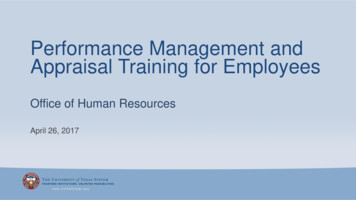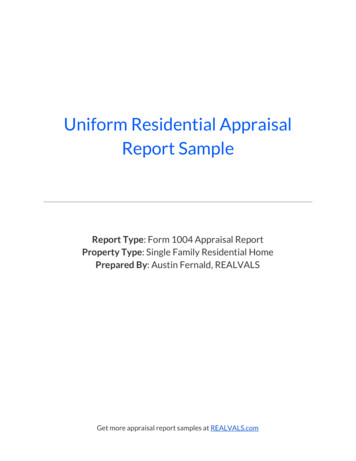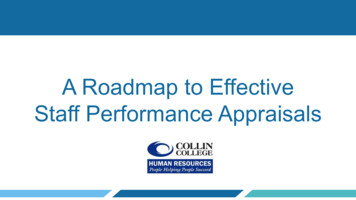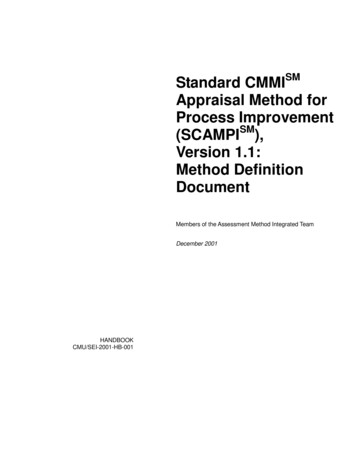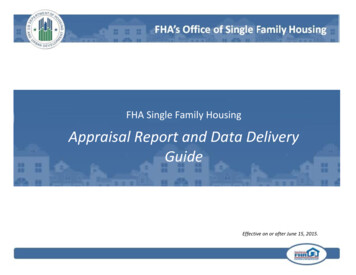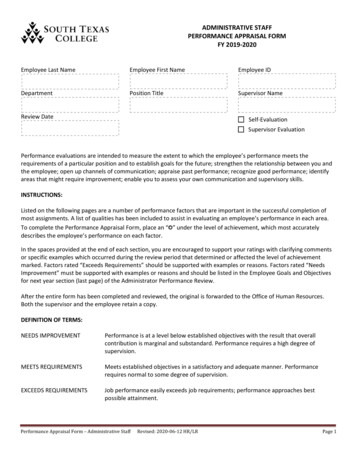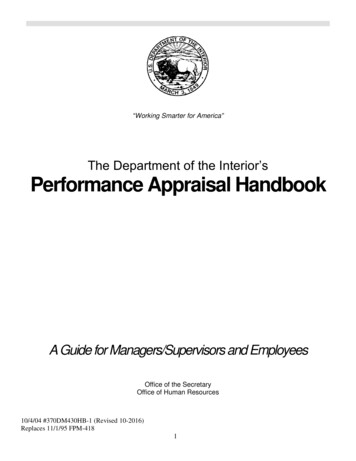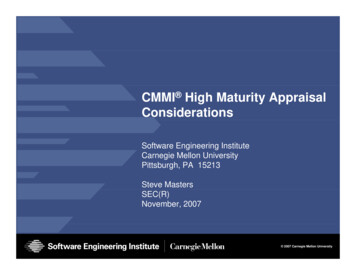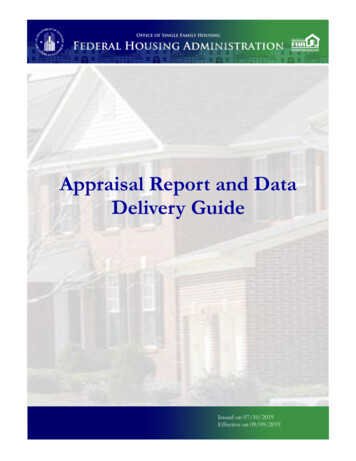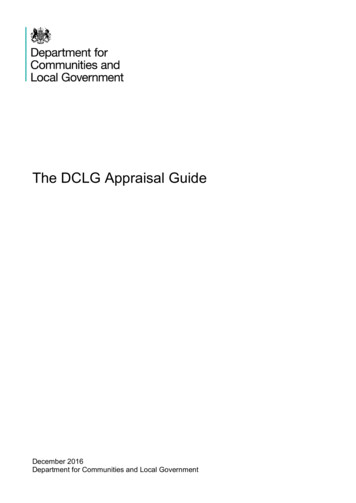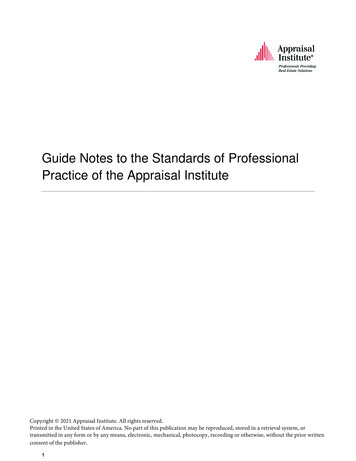
Transcription
Guide Notes to the Standards of ProfessionalPractice of the Appraisal InstituteCopyright 2021 Appraisal Institute. All rights reserved.Printed in the United States of America. No part of this publication may be reproduced, stored in a retrieval system, ortransmitted in any form or by any means, electronic, mechanical, photocopy, recording or otherwise, without the prior writtenconsent of the publisher.1
Table of ContentsHistory of the Guide NotesGuide Note 3: The Use of Form Appraisal Reports for Residential PropertyGuide Note 4: Reliance on Reports Prepared by OthersGuide Note 6: Consideration of Hazardous Substances in the AppraisalProcessGuide Note 8: Use and Applicability of Letters of TransmittalGuide Note 10: Development of an Opinion of Market Value in theAftermath of a DisasterGuide Note 11: Comparable Selection in a Declining MarketGuide Note 12: Analyzing Market TrendsGuide Note 13: Performing Evaluations of Real Property Collateralfor LendersGuide Note 14: Concept of Exposure TimeGuide Note 15: Assumptions and Hypothetical ConditionsGuide Note 16: ArbitrationGuide Note 17: Compliance with the Code of Professional Ethics and Standards ofStandards of Professional Practice of the Appraisal InstituteGuide Note 18: Personal Characteristics and Valuation Practice200 W. Madison St., Suite 1500, Chicago, IL 60606 T 312-335-4100 F 312-335-4400 www.appraisalinstitute.org2
History of the Current Guide NotesGuide Note 1: See History of the Retired Guide NotesGuide Note 2: See History of the Retired Guide NotesGuide Note 3: The Use of Form Appraisal Reports for Residential Property January 1, 1991: Adopted May 5, 1995: Amended November 12, 2002: AmendedGuide Note 4: Reliance on Reports Prepared by Others January 1, 1991: Adopted as “Reliance on Reports or Information Prepared by Others “ (Note:This Guide Note was initially numbered as Guide Note 6. A previous Guide Note 4 that addressedDiscounted Cash Flow as a Valuation Method is retired – See History of Retired Guide Notes.) January 16, 1993: Amended January 1, 2003: Guide Note title changed to “Reliance on Reports Prepared by Others” andGuide Note number changed to 4. December 13, 2011: AmendedGuide Note 5: See History of the Retired Guide NotesGuide Note 6: Consideration of Hazardous Substances in the Appraisal Process January 1, 1991: Adopted as “The Consideration of Hazardous Substances in the AppraisalProcess” (Note: This Guide Note was initially numbered as Guide Note 8) January 1, 2003: Guide Note number changed to 6. July 26, 2013: AmendedGuide Note 7: See History of the Retired Guide NotesGuide Note 8: Use and Applicability of Letters of Transmittal August 5, 1994: Adopted (Note: This Guide Note was initially numbered as Guide Note 10) January 28, 1994: Amended January 1, 2003: Guide Note number changed to 8. August 4, 2012: AmendedGuide Note 9: See History of the Retired Guide NotesGuide Note 10: Development of an Opinion of Market Value in the Aftermath of a Disaster November 5, 2010: AdoptedGuide Note 11: Comparable Selection in a Declining Market November 15, 2011: AdoptedGuide Note 12: Analyzing Market Trends May 7, 2012: AdoptedGuide Note 13: Performing Evaluations of Real Property Collateral for Lenders October 31, 2012: AdoptedGuide Note 14: Concept of Exposure Time February 7, 2013: Adopted3
Guide Note 15: Assumptions and Hypothetical Conditions November 19, 2015: AdoptedGuide Note 16: Arbitration November 17, 2016: AdoptedGuide Note 17: Compliance with the Code of Professional Ethics and Standards of ProfessionalPractice of the Appraisal Institute November 12, 2020: AdoptedGuide Note 18: Personal Characteristics and Valuation Practice May 6, 2021: AdoptedHistory of the Retired Guide NotesGuide Note 1: Valuation of Real Estate Component of Real Estate Limited Partnership Interests January 1, 1991: Adopted as “Valuation of Real Estate Interests Intended for Syndication andValuation of Real Estate Partnership Interests” January 16, 1993: Amended January 1, 2003: Guide Note title changed to “Valuation of Real Estate Component of Real EstateLimited Partnership Interests” May 8, 2012: RetiredGuide Note 2: Cash Equivalency in Valuations January 1, 1991: Adopted as “Cash Equivalency in Value Estates in Accordance with StandardsRule 1-2(b)” January 28, 1994: Guide Note title changed to “Cash Equivalency in Value Estates in Accordancewith Standards Rule 1-2(c)” November 12, 2002: Guide Note title changed to “Cash Equivalency in Valuations” November 16, 2018: RetiredGuide Note 4: Discounted Cash Flow Analysis as a Valuation Method January 1, 1991: Adopted July 23, 1993: RetiredGuide Note 5: Value Estimates as of a Retrospective or Prospective Date January 1, 1991: Adopted July 23, 1993: RetiredGuide Note 5: Appraisals of Real Estate with Related Personal Property, Business Property orIntangible Assets January 1, 1991: Adopted as “Appraisals of Real Estate with Related Personalty” (Note: ThisGuide Note was initially numbered as Guide Note 7. A previous Guide Note 5 that addressedValue Estimates as of a Retrospective or Prospective Date is retired– See History of RetiredGuide Notes.) January 1, 2003: Guide Note title changed to “Appraisals of Real Estate with Related PersonalProperty, Business Property or Intangible Assets” and Guide Note number changed to 5. May 6, 2011: Amended August 7, 2020: RetiredGuide Note 7: Consideration of the Americans with Disabilities Act in the Appraisal Process.4
January 16, 1993: Adopted as “The Consideration of the Americans with Disabilities Act in theAppraisal Process” (Note: This Guide Note was initially numbered as Guide Note 9)January 1, 2003: Guide Note title changed to “Consideration of the Americans with DisabilitiesAct in the Appraisal Process” and Guide Note number changed to 7.November 16, 2012: RetiredGuide Note 9: Use and Applicability of Engagement Letters December 2, 1995: Adopted (Note: This Guide Note was initially numbered as Guide Note 11) January 1, 2003: Guide Note number changed to 9. May 2, 2013: Retired5
Guide Note 3The Use of Form Appraisal Reportsfor Residential PropertyIntroductionMost residential appraisal assignments require a report onbe completed in accordance with the appraisal developmentone of the approved forms used in the secondary mortgageand reporting requirements of the Standards of Professionalmarket or by the employee-relocation industry. Use of suchAppraisal Practice and the Certification Standard and Code offorms does not lessen or change the appraiser’s obligationProfessional Ethics of the Appraisal Institute, the assignmentto observe the requirements of the Standards of Professionalmust not be accepted.Appraisal Practice. If a proposed appraisal assignment cannot6
GUIDE NOTE 3Basis for Proper EvaluationWhen using any form report, or signing a form report as a reviewer, it is the responsibility of the appraiser and the reviewer toensure that the appropriate methods and techniques have been properly employed. Appropriate addenda must be added whenadditional information is required to complete the appraisal report in accordance with Standard 2 of USPAP.Highest and best use appears on most forms merely as a box to be checked because the use of the form itself is a statementof highest and best use. Unless a detailed explanation is added to clarify, it is inappropriate to use a single-family dwelling reportform if the appraiser concludes that the highest and best use of the property is a different use.Summary of Standard Practices1.Consider the intended use, purpose, definitions, assumptions, conditions, and limitations that are inherent in2.Sign an appraisal report as a reviewer only when accepting full responsibility for the contents of the report3.Analyze and report any prior sales of the property being appraised within three years of the date of thethe form report used for a residential appraisal (USPAP SR 1-2 (a) through (h)).(USPAP SR 2-3 and Standard 3).appraisal USPAP SR 2-2(a)(ix), 2-2(b)(x), and 2-2(c)(ix)).(Please Note: The purpose of the Guide Notes to the Standards of Professional Appraisal Practice is to provideMembers, Candidates, Practicing Affiliates and Affiliates with guidance as to how the requirements of theStandards may apply in specific situations.)Effective November 12, 2002Minor revisions 20177
Guide Note 4Reliance on Reports Prepared by OthersIntroductionIn this Guide Note an analysis, opinion, or conclusionservices and will need more information to make decisionsprepared by others, and upon which an appraiser relies, isand develop their appraisals. Reports prepared by othersreferred to as a “report.” Appraisers often rely, at least invary in form, content, and applicability. Although they arepart, on reports prepared by others. Reliance on the reportsfrequently used in conjunction with proposed propertiesof others generally increases with the complexity of theand transactions, they may also be applicable to existingappraisal problem. The use of such reports may increase inproperties and used in special situations such as litigationthe future. Appraisers are providing more specializedand arbitration.8
GUIDE NOTE 4Introduction (continued)According to USPAP, in the Comment to SR 2-3, appraisers have specific obligations when relying on reports prepared by others:When a signing appraiser(s) has relied on the work done by appraisers and others who do not sign the certification, thesigning appraiser is responsible for the decision to rely on their work. The signing appraiser(s) is required to have areasonable basis for believing that those individuals performing the work are competent. The signing appraiser(s) alsomust have no reason to doubt that the work of those individuals is credible.In general, these reports fall into four major classifications:General Informational ReportsGeneral informational reports are usually descriptive in nature and provide information pertaining to an overall area. Theyinclude data on demographics, economic trends, and other such matters. They are not specific to the property being appraised.Reports Prepared by Licensed or Certified Non-Real Estate Appraisal ProfessionalsReports prepared by licensed or certified non-real estate appraisal professionals are specific to the subject property and maybe either descriptive or factual in nature. They include engineering services, environmental studies, soil reports, impactstudies, survey reports, zoning opinions, audited financial statements, and other reports relating to matters beyond thescope of appraisers’ expertise, or services not typically offered by appraisers.Reports Prepared by Other Non-Real Estate Appraisal ProfessionalsReports in this category are prepared by experts who are not licensed or certified but have specific experience or expertisethat an appraiser may rely upon. Examples include reports pertinent to the appraisal problem from academicians, operatorsof special use properties, and personal property valuers.Other ReportsOther reports pertaining to the subject property may be prepared by the client, by another real estate professional, or byothers. These reports include financial statements, rent rolls, prior appraisal reports on the subject property, highest andbest use studies, rental surveys, computer programs (or other electronic media), cost studies, and others.Basis for Proper EvaluationBefore relying upon reports prepared by others the appraiser must:1. have a reasonable basis for believing the individuals preparing the report(s) are competent;2. have no reason to doubt the credibility of the work of the work preparer(s);3. consider the criteria under which the reports were prepared;4. consider the source and extent of the instructions given to the preparer of the reports;5. determine how the appraiser might rely on this information in making decisions and preparing his or her report; and6. determine the process and procedures used to evaluate the reports prepared by others.9
Basis for Proper Evaluation (continued)The valuation process may require projections which are influenced by uncertain events. For this reason the basis for all assumptionsand projections employed by the individual who prepared the report must be understood and properly utilized by the appraiser.USPAP Standards Rules 1-1(b) and 3-1(b) state that the appraiser must not commit a substantial error of omission or commission thatsignificantly affects the appraisal or the appraisal review. USPAP Standards Rules 1-1(c) and 3-1(c) state that the appraiser must notmake a series of errors that, although individually might not significantly affect the results, in the aggregate affect the credibility ofthose results.USPAP Standards Rules 2-1(a) and 3-4(a) require that each written or oral appraisal or appraisal review report clearly and accuratelyset forth the appraisal or appraisal review in a manner that will not be misleading. USPAP Standards Rules 2-1(b) and 3-4(b) requirethat each written or oral appraisal or appraisal review report must contain sufficient information to enable the intended users tounderstand the report properly. USPAP Standards Rules 2-2(a)(xi), and b(x) and 3-5(f) require that each written appraisal report orappraisal review report clearly and conspicuously state all extraordinary assumptions and hypothetical conditions. USPAP StandardsRules 2-2(a)(viii), requires the appraiser to summarize in the appraisal report the information analyzed, the appraisal methods andtechnologies employed, and the reasoning that supports the analyses, opinions, and conclusions; exclusion of the sales comparisonapproach, cost approach or income approach must be explained. USPAP Standards Rule 2-2(b)(viii) requires the appraiser to state inthe report the appraisal method and techniques employed, and the reasoning that supports the analyses, opinions, and conclusions;exclusion of the sales comparison approach, cost approach or income approach must be explained. USPAP Standards Rule 2-2(b)(viii)requires the appraiser to state in the report the appraisal method and techniques employed, state the value opinion(s) reached, andreference the workfile; exclusion of the sales comparison approach, cost approach, or income approach must be explained, and 2-2(b)(vii), and 3-5(g) require the appraiser to address the assignment’s scope of work in the appraisal or appraisal review report.Market value opinions should be supported by market-derived data and assumptions made should be specific to both the market andthe property. An appraiser who accepts the projections or assumptions of others without some assurance of the accuracy orreasonableness of the calculations or information provided may violate the aforementioned USPAP Standards Rules.The four major classifications of reports require varying levels of review and care on the part of the appraiser, as offered below:General Informational ReportsGeneral informational reports usually require limited verification. Most discrepancies are easily clarified.Reports Prepared by Licensed or Certified Non-Real Estate Appraisal ProfessionalsReports prepared by licensed or certified non-real estate appraisal professionals typically offer conclusions as to the adequacy of aspecific property component or issue pertaining to the property. These conclusions are generally based on accepted procedures orstandards and represent informed opinions on matters beyond the appraiser’s expertise. Absent reasonable doubt, these reportsusually can be accepted conditioned upon the qualification that they were prepared by recognized professionals. Should observed orapparent material discrepancies exist between the appraiser’s investigation and the submitted report prepared by a licensed orcertified non-real estate appraisal professional, such material discrepancies must be disclosed.Reports Prepared by Other Non-Real Estate Appraisal ProfessionalsAn appraiser’s reliance on reports prepared by these experts is distinct from that of the preceding paragraph in the greater care theappraiser should exercise in determining the pertinent expertise of the author. USPAP Standards Rule 2-3, in the Comment, requiresthat such reports may only be used if the signing appraiser has a reasonable basis for believing that individuals who performed thework are competent and has no reason to doubt the work of those individuals is credible.10
Basis for Proper Evaluation (continued)Other 3-3 ReportsOther reports prepared by, or at the direction of, the client, other real estate professionals, or others, require a careful reviewfor reasonableness. To the degree possible and practical, computer programs or other electronic media should be reviewed forerrors or inconsistencies. The level of investigation should be appropriate to the problem. The appraiser must understand theassumptions on which these reports are based as well as their applicability and validity to the assignment.Summary of Standard Practices1.Become familiar with any report prepared by another that is relied upon in the appraisal process and, tothe degree possible, understand the basis for its conclusions. Address any questions with the preparer ofthe report prior to using it in the appraisal process.2.In conjunction with the scope of work for the assignment, identify or reference in the appraisal report any reportprepared by another that was relied upon in developing the appraisal or appraisal review opinion or conclusion.(Please Note: The purpose of the Guide Notes to the Standards of Professional Appraisal Practice is to provideMembers, Candidates, Practicing Affiliates and Affiliates with guidance as to how the requirements of theStandards may apply in specific situations.)Effective January 1, 2012Minor revisions 201711
Guide Note 6Consideration of Hazardous Substancesin the Appraisal ProcessIntroductionThe consideration of environmental conditions along withmore general environmental conditions might be apparent tosocial, economic, and governmental conditions is fundamentala member of the general public who is not specifically trainedto the appraisal of real property. Although appraisal literatureas an expert in observing these forces. There is, however,has recognized environmental conditions can affect propertya growing need to give special consideration to the specificvalue, the focus has been on the consideration of climaticimpacts of hazardous substances on the valuation of realconditions, topography and soil, the surrounding neighborhood,property. Consistent with accepted guidance on this topicaccessibility, and proximity to points of attraction. Theseand as incorporated herein, “hazardous substances”12
GUIDE NOTE 6Introduction (continued)would be considered “environmental contamination” when their concentrations exceed appropriate regulatory standards.(See Definitions below).The purpose of this Guide Note is to provide guidance in the application of the Standards of Valuation Practice (SVP) and theUniform Standards of Professional Appraisal Practice (USPAP) to the appraisal of real property affected by or potentiallyaffected by environmental contamination and, in particular, to the consideration of environmental contamination in the appraisalprocess. It is not the purpose of this Guide Note to provide technical instructions or explanations concerning the detection ormeasurement of the effect of hazardous substances.CompetencyThe Competency Rule of the USPAP, for example1, requires the appraiser to either:a) properly identify the problem to be addressed, and have the knowledge and experience necessary to complete theassignment competently, and recognize and comply with laws and regulations that apply to the appraiser or to theassignment; orb) disclose the appraiser’s lack of knowledge and/or experience to the client before accepting the assignment, take all stepsnecessary or appropriate to complete the assignment competently, and describe the lack of knowledge and/orexperience and the steps taken to complete the assignment competently in the report; orc) decline or withdraw from the assignment.The competency provisions of valuation Standards and Ethical Rules are of particular importance in the appraisal of real property thatmay be affected by hazardous substances. Most appraisers do not have the knowledge or experience required to detect the presenceof hazardous substances or to measure the quantities of such material. The appraiser, like the buyers and sellers in the open market,typically relies on the advice of others in matters that require special expertise.There is nothing to prevent a professional appraiser from becoming an expert in other fields but the real estate appraiser isneither required, nor expected, to be an expert in the special field of the detection and measurement of hazardous substances.This Guide Note therefore addresses the problem of hazardous substances from the viewpoint of the appraiser who is notqualified to detect or measure the quantities and concentrations of hazardous substances. If an appraiser is qualified to detector measure hazardous substances, a different set of standards would apply.In appraisal assignments in which the appraised value is to take into account the effects on value of hazardous substances,most appraisers require the professional assistance of others. In appraisal assignments in which the appraised value does nottake into account the possible effects on value of known hazardous substances (i.e. the unimpaired value, see below), theappraiser would not require the professional assistance of others.The appraiser may accept an assignment involving the consideration of hazardous substances without having the requiredknowledge and experience in this special field, provided the appraiser discloses such lack of knowledge and experience to theclient prior to acceptance of the assignment, arranges to complete the assignment competently and describes the lack ofknowledge or experience and the steps taken to competently complete the assignment in the report. This may requireassociation with others who possess the required knowledge and experience or reliance on professional reports prepared byothers who are reasonably believed to have the necessary knowledge and experience. If the appraiser draws conclusions basedupon the advice or findings of others, the appraiser must have a reasonable basis for believing that the advice or findings aremade by persons who are competent. (See Guide Note 4: Reliance on Reports Prepared by Others and the USPAP Commentto SR 2-3.)1Ethical Rule 1-3 of the Code of Professional Ethics of the Appraisal Institute and paragraph 50 of the IVS Framework of theInternational Valuation Standards (IVS) contain similar provisions.13
Scope of WorkThe SVP’s Standards Rule A-3: Scope of Work requires the valuer to “determine the scope of work necessary to develop an appraisalthat is credible given its intended use.”The USPAP SCOPE OF WORK RULE requires that, in any assignment, the appraiser establish the appropriate scope of work necessaryto complete that assignment. Part of the scope of work decision includes how, and to what extent, the appraisal problem will addressknown or suspected hazardous materials that may impact the property. Both the SVP and USPAP provide two tests for the acceptabilityof the scope of work decision; the intent and meaning is the same in both the SVP and USPAP. The Comment to the USPAP Scope ofWork Acceptability section states:The scope of work is acceptable when it meets or exceeds: the expectations of parties who are regularly intended users for similar assignments; and what an appraiser’s peers’ actions would be in performing the same or a similar assignment. An appraiser must be prepared to support the decision to exclude any investigation, information, method or technique thatwould appear relevant to the client, another intended user, or the appraiser’s peers.The USPAP Scope of Work Acceptability section includes two more major provisions: An appraiser must not allow assignment conditions to limit the scope of work to such a degree that the assignmentresults are not credible in the context of the intended use. An appraiser must not allow the intended use of an assignment or a client’s objectives to cause the assignment resultsto be biased.The disclosure obligations of the USPAP SCOPE OF WORK RULE and USPAP SR 2-2(a)vii) and (b)(vii) and the SVP’s C-2(Xii) require thatthe scope of work performed be disclosed in the appraisal report.Depending on the intended use, the appraisal may be prepared so that the value opinion reflects no known or suspectedenvironmental contamination that may impact the property, or it may be prepared so that the value opinion does reflect knowncontamination. In either case, the appraiser must take special precautions in the development and reporting process to ensure thatthe results of the assignment are credible and that the report is not misleading.Extraordinary/Special Assumptions and Hypothetical ConditionsIn assignments involving contaminated properties or properties that may be adversely impacted by environmental contamination(contaminated property assignment), the appraisal will likely be premised on one or more Extraordinary/Special Assumptions and/orHypothetical Conditions. Typically in these types of assignments, Extraordinary/Special Assumptions are used when relying on the workof others, such as environmental engineers or other technical specialists, while Hypothetical Conditions are used when the appraiserestimates the value of a property known to be contaminated in an unimpaired or uncontaminated condition2iThe Appraisal Institute Standards of Valuation Practice (SVP) address assumptions and hypothetical conditions in theDefinitions section (definitions of hypothetical condition and special assumption), SR A-2(g), SR B-2(e), SR C-2(a)(xvi) and SR C-2(b)2(xiii). Portions of the Appraisal Institute Code of Professional Ethics (CPE) that relate to this topic include ER 3-4 and ER 3-5.Applicable sections of the Uniform Standards of Professional Appraisal Practice (USPAP) include the Definitions section(definitions of hypothetical condition and extraordinary assumption); SR 1-2(f) and (g), SR 2-1(c), SR 2-2(a) and (b)(xi); and SR 3-2(f)and 4-2(f). Applicable sections of the International Valuation Standards (IVS) include the Definitions section (definition of specialassumption); IVS 101 Scope of Work, 20.3 (k); IVS 103 Reporting 10.2, and Bases of Value, 200.4 and 200.5.14
Assignments prepared under USPAPUSPAP provides the following definition for “extraordinary assumption.”An assumption, directly related to a specific assignment, as of the effective date of the assignment results, which, iffound to be false, could alter the appraiser’s opinions or conclusions.Comment: Extraordinary assumptions presume as fact otherwise uncertain information about physical, legal, oreconomic characteristics of the subject property; or about conditions external to the property, such as marketconditions or trends; or about the integrity of data used in an analysis.In addition, it may be appropriate to premise the appraisal on an extraordinary assumption in the event there is suspected butnot confirmed contamination. An environmental assessment by a qualified environmental professional would be required for suchconclusions or determinations.USPAP Standards Rule 1-2(f) requires that in developing an appraisal the appraiser identify “any extraordinary assumptionsnecessary in the assignment.” The Comment states:“An extraordinary assumption may be used in an assignment only if: it is required to properly develop credible opinions and conclusions; the appraiser has a reasonable basis for the extraordinary assumption; use of the assumption results in a credible analysis; and the appraiser complies with the disclosure requirements set forth in USPAP for extraordinary assumptions.”USPAP Standards Rules 2-2(a) and (b)(xi) require the appraiser to clearly and conspicuously state in the appraisal report allextraordinary assumptions upon which the value opinion is premised. These reporting Standards Rules also require a clear andconspicuous statement that the use of these extraordinary assumptions “might have affected the assignment results.”USPAP Standards Rule 2-1 requires the report to “clearly and accurately disclose all extraordinary assumptions used in theassignment.”USPAP provides the following definition for “hypothetical condition”:“A condition, directly related to a specific assignment, which is contrary to what is known by the appraiser to exist on theeffective date of the assignment results, but is used for the purpose of analysis.Comment: Hypothetical conditions are contrary to known facts about physical, legal, or economic characteristics of thesubject property; or about conditions external to the property, such as market conditions or trends; or about the integrity of dataused in the analysis.”USPAP Standards Rule 1-2(g) requires that in developing an opinion of value the appraiser identify “any hypothetical conditionsnecessary in the assignment.” The Comment states:“A hypothetical condition may be used in an assignment only if: use of the hypothetical condition is clearly required for legal purposes, for purposes of reasonable analysis, or forpurposes of comparison; use of the hypothetical condition results in a credible analysis; and the appraiser complies with the disclosure requirements set forth in USPAP for hypothetical conditions.”USPAP Standards Rule 2-1(c) requires the report to “clearly and accurately disclose all extraordinary assumptions, hypotheticalconditions used in the assignment.”15
USPAP SR 2-2(a)(xi) and (b)(xi) require the appraisal to “clearly and conspicuously” state all extraordinary assumptions and hypotheticalconditions and state that their use “might have affected the assignme
Reports Prepared by Licensed or Certified Non-Real Estate Appraisal Professionals Reports prepared by licensed or certified non-real estate appraisal professionals are specific to the subject property and may be either descriptive or factual in nature. They include engineer
